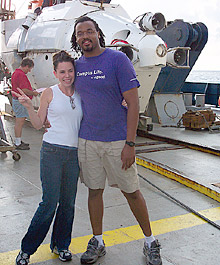
College of William and Mary research technician Megan Ward and Savannah State University undergraduate John Braxton, before their dive in Alvin to the Blake Ridge Diapir. Click image for larger view.
In Search of Ice Shrimp and Gas Hydrate at The Blake Ridge Diapir
July 30, 2003
Dr. Carolyn Ruppel, Co-Chief Scientist
Associate Professor
Georgia Institute of Technology
Catalina Martinez, Mission Coordinator
NOAA Office of Ocean Exploration
Dive 3912 took Alvin pilot Bruce Strickrott, lead observer Megan Ward, and starboard observer John Braxton back to the Blake Ridge Diapir to complete sampling of live clams and to survey new areas of the seep site. Although this bizarre landscape of clam and mussel beds, bacterial mats, carbonate boulders and outcrops, cake urchins, and other deep sea organisms had already been visited twice during The Windows to the Deep expedition, this was the first dive to this site for the observers and the only dive to spend time sampling as close as possible to the methane hydrate.
Megan Ward, a veteran of a previous Alvin dive, is a research technician in the lab of co-Chief Scientist Cindy Van Dover at The College of William and Mary. Her Master’s degree, completed under Van Dover in early 2003, focused on a pathogenic virus discovered in mussels collected in 2001 from the Blake Ridge Diapir. John Braxton is a senior undergraduate at Savannah State University and currently does microbiology research in the laboratory of Dr. Mark Frischer at Skidaway Institute of Oceanography. Under the guidance of mentor Dr. Jennifer Brofft, John is conducting genetic studies of heterotrophic nitrate-reducing bacteria. Although John is a veteran of several oceanographic cruises aboard smaller UNOLS vessels, Dive 3912 was his first visit to the seafloor.
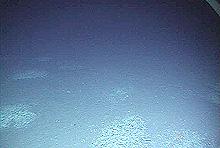
The distribution of clam patches on the seafloor as seen during Dive 3912. Photo courtesy of WHOI. Click image for larger view.
During this final dive at the Blake Ridge Diapir, the researchers planned to map the southern and western extent of the seep communities, to finish sampling of live vesicomyid clams, and to obtain samples as close as possible to the methane hydrate that was first discovered at the seafloor at this site in 2001. Alvin landed several hundred meters south of the seep and proceeded north to a location where live clams were obtained during Dive 3910. Unlike the mussels, which live in large beds tens of meters across, the live clams recovered during The Windows to the Deep expedition occurred in smaller patches approximately 60 m x 80 m. The daily log for Dive 3910 describes the relationship between sulfide and methane venting at the site and the distribution of clams and mussels.
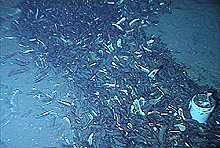
A field of mussels and the bucket of rabbit chow deployed as part of a long term experiment in ecological succession at seep sites, under the direction of Louisiana State University researcher Bob Carney. Photo courtesy of WHOI. Click image for larger view.
The observers also photographed a bucket of rabbit chow left on the seafloor in 2001 as part of a long term biological monitoring experiment. Dr. Robert Carney of Louisiana State University has for many years asked colleagues to place rabbit chow at seep sites during dives with occupied submersibles. During subsequent visits to these sites, the buckets are photographed, but not disturbed, to record colonization by seep organisms. Such long-term ecology experiments are still relatively rare in the deep ocean, which is a difficult environment in which to deploy devices that are untended for years at a time.
A highlight of this dive was an extended visit to the methane hydrate found during the 2001 NOAA/NURP Deep East 3 expedition. The methane hydrate forms beneath a rock overhang that traps bubbles being emitted from the seafloor. Normally, methane reaching the seafloor would simply dissolve in bottom water. Beneath the overhang, the water has reached methane saturation, meaning that no more methane can be dissolved. As methane bubbles emerge from the seafloor, gas hydrate forms a shell around the bubble, which then ascends and attaches to the bottom of the gas hydrate deposit. Comparison between photos taken at the site in 2001 and during Dive 3912 shows that the gas hydrate deposit is either smaller than in 2001 or obscured from view by sediment movement that has occurred since 2001.
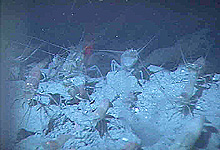
Ice shrimp congregate beneath the overhang that caps the methane hydrate. Photo courtesy of WHOI. Click image for larger view.
Alvin pilot Strickrott maneuvered the front of the sub downward toward the methane hydrate deposit and held the sub in this position while using the manipulator arms to delicately place push core tubes very close to the gas hydrate. During this operation, the observers noted more than a dozen ice shrimp beneath the ledge in the vicinity of the hydrate. Each time a push core was removed from the sediment, shrimp crowded the small depression left by the push core, possibly to feed on material stirred up by the coring.
Just as the last of the three push cores entered the sediment, methane bubbles streamed out. This was an exciting moment for the observers, who can be heard exclaiming “That’s so cool!” on the audio record of the dive. The third push core emitted methane bubbles during much of Alvin’s ascent to the surface a few hours later, leading the scientists to conclude that the core had contained gas hydrate when originally acquired. Gas hydrate is stable at the high pressures and low temperatures found at the seafloor, but it breaks down to methane gas and water at the low pressures and higher temperatures characteristic of the shallow part of the water column and the surface.
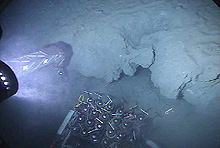
Methane bubbles rising in the water column as the third push core was inserted just below the gas hydrate deposit, which is not visible in this photo. Photo courtesy of WHOI. Click image for larger view.
The push cores collected near the Blake Ridge Diapir gas hydrate will be used by Georgia Tech Ph.D. students Heath Mills and Rob Martinez for microbial ecology studies in the laboratory of Dr. Patricia Sobecky of the School of Biology. Mills and Martinez have been using DNA- and RNA-based techniques to study the phylogenetic diversity of microbial communities associated with cold seeps in the Gulf of Mexico. The samples obtained during Dive 3912 will lead to the first comparison ever undertaken between free-living methane seep microbes in the Gulf of Mexico and the Blake Ridge.
Before ascending to the surface, the scientists collected a hand specimen of authigenic carbonate from the seafloor. This type of carbonate, which is formed as a result of microbial processes, is diagnostic of seep environments. To constrain the source of the carbonate, University of Virginia Ph.D. student Bill Gilhooly will conduct carbon isotopic analysis on the sample.
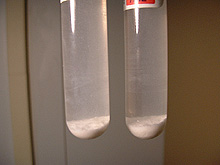
The white material collected in the bottom of these test tubes is zinc sulfide that has settled out of pore water from push cores taken during this cruise. Photo courtesy of A. Eisen. Click image for larger view.
What is that smell? Hydrogen sulfide gas!
Bill Gilhooly, Ph.D. student
University of Virginia
If you’ve ever driven to the beach, you’ve probably noticed a rotten egg smell as you passed the back-bay area where sawgrass and cattails grow. And, if you’ve ever walked out onto the flats and dug down into the mud, you’d probably see that the color of the mud goes from light brown to black. The odor is from a gas called hydrogen sulfide that is produced by bacteria below the surface of the marsh muds.
The water in the bay is usually no deeper than five feet and composed of a mixture of fresh and saltwater. The fish and bacteria that live there quickly use up the oxygen dissolved in the shallow brackish water. Their biological activity prevents oxygen from seeping into the sediments, and the mud becomes anaerobic, meaning “without oxygen.” This is the dark layer of mud where hydrogen sulfide is produced. Most consumers such as fish and frogs need oxygen to live, but there are many kinds of bacteria that live best in the absence of oxygen. Most of the sulfur in marine waters is in the form of sulfate, and some bacteria live off of this kind of sulfur. These bacteria are called sulfate reducers because they convert sulfate into hydrogen sulfide.
Our understanding of the near-shore environment becomes useful when we study the deep sea. Oxygen does not penetrate deep down into the mud at the bottom of the ocean. Thus, the mud at the Blake Ridge becomes anaerobic just 1 inch below the surface. Sulfate reducers produce hydrogen sulfide in the ocean bottom much like they do in the salt marsh. At nearly two miles below the surface of the ocean, hydrogen sulfide in the sediments of the Blake Ridge supports abundant life. The Blake Ridge is a unique deep sea environment in that it receives gases that vent up from within the earth as gas hydrate. At this “cold seep” area, scientists have discovered clams and mussels that receive nutrients from the bacteria that live in their gills. Just as plants produce energy by converting carbon dioxide into sugars through a process called photosynthesis, the bacteria that inhabit the gills of clams and mussels are another kind of sulfur utilizing bacteria that provide energy for their hosts by converting hydrogen sulfide into sulfate through a process called chemosynthesis.
These chemosynthetic organisms are the base of the food chain at the Blake Ridge much like plants are the base of the food chain on land. One of the scientific goals of our current investigation of the Blake Ridge is to measure the amount of sulfur in the sediments and determine how the bacteria make it available to their host organisms.
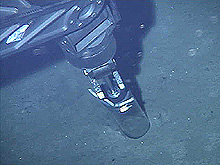
A push core being taken by Alvin’s manipulator in sediment at 3455 m during dive 3908. Photo courtesy of WHOI. Click image for larger view.
We can gain a better understanding of the Blake Ridge environment by collecting bottom samples and analyzing the water trapped between the individual grains of sediment. This water is called “pore water,” which we can analyze by collecting sediment samples with the deep sea submersible Alvin. The Alvin has a mechanical arm that can push a clear plastic tube into the ocean bottom and extract the sediment. The core is then carried to the surface and taken to the laboratory for analysis. The ocean mud is cut into small mud cakes and placed into a device called a “squeezer” to press the water out of the mud. We can trap the sulfate and hydrogen sulfide dissolved in the pore water using chemical reactions. We then take these preserved sulfur samples to the laboratory on land to analyze how much and what kind of sulfur is present in the pore water trapped within the mud under mussel and clam beds. The geochemical data collected from the pore water will provide a better understanding of how bacterial activity can support the abundant life found in deep sea cold seep environment of the Blake Ridge.


















